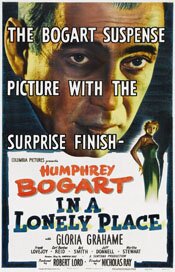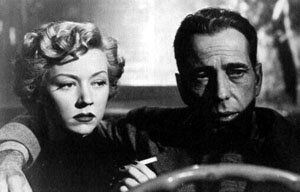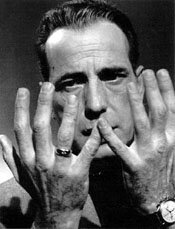 Directed by Nicholas Ray
Directed by Nicholas Ray
Watching In a Lonely Place, I couldn’t help recalling all those English Lit classes about tragedy and the hero with a tragic flaw.
This is a film noir with Humphrey Bogart playing such a character and the result is a great, if heartbreaking, movie.
As someone else commented (somewhere on the Web – I don’t remember where), it’s a little eyebrow raising to find out the set was a replica of a place where director Nicholas Ray lived and the film is called In a Lonely Place.
This is a movie about loneliness. As with many noir films, the hero (or anti-hero) is an outsider. He’s isolated from everyone around him. Here, however, he has a chance to alleviate that loneliness, finding love with a woman he feels understands him (Gloria Grahame).
Humphrey Bogart plays Dixon Steele, a Hollywood screenwriter with a less than stellar career. He’s cynical about the business he’s in, dislikes its commercialism, and goes about with a chip on his shoulder. He also has a volatile temper. The anger he carries around with him is generally repressed but always on the verge of boiling over. Often, it does.
He’s given a novel to read to see what he can do about turning it into a script. But rather than read the novel, he gets a starry-eyed hatcheck girl to come over to his place and tell him the story (since she has read it).
Later, after leaving, the girl is found murdered. Steele becomes a suspect, the lead detective’s prime candidate.
 Steele has an alibi, however. It comes by way of Laurel Grey (Grahame), his neighbour across the courtyard. Steele and Grey develop a relationship and are soon in love. This love frees Dixon from his demons, at least for a time, and he starts riding a creative wave, writing the script he’s been asked for but, at the same time, turning it from a trashy novel into something considerably better.
Steele has an alibi, however. It comes by way of Laurel Grey (Grahame), his neighbour across the courtyard. Steele and Grey develop a relationship and are soon in love. This love frees Dixon from his demons, at least for a time, and he starts riding a creative wave, writing the script he’s been asked for but, at the same time, turning it from a trashy novel into something considerably better.
But the investigation of the murder haunts Dixon and Laurel. His temper soon resurfaces and she sees this part of him. Soon, she (and we, the audience) start to wonder if Steele is innocent or not. His temper certainly makes it seem possible he committed the crime.
Doubt and distrust begin to eat away at Dixon and Laurel’s relationship and it soon starts to spiral downward.
 Bogart is tremendous in this movie and you could make a good case for this being his best performance. While you can empathize with him to an extent, and want the relationship of Dixon and Laurel to work, you can’t help also disliking him because of his anger and suspicions. With a personality such as his, with his emotional problems, it’s easy to see how if the relationship were to work it would soon become characterized by domestic violence.
Bogart is tremendous in this movie and you could make a good case for this being his best performance. While you can empathize with him to an extent, and want the relationship of Dixon and Laurel to work, you can’t help also disliking him because of his anger and suspicions. With a personality such as his, with his emotional problems, it’s easy to see how if the relationship were to work it would soon become characterized by domestic violence.
Gloria Grahame is also perfect. It’s difficult to imagine anyone else in this role. You can see the love and fear battling within her. In noir movies, she’s the ideal femme fatale. (See The Big Heat, for example.)
The movie also has a perfect ending. It has something of a twist to it but it doesn’t seem forced or imposed. Rather, it seems inevitable.
While In a Lonely Place begins with the appearance of a potboiler murder story (which I gather the book it came from was), the murder here is just an excuse to tell the the real story – the relationship between Dixon and Laurel, and how Dixon’s flaw affects and determines its end.
Note:
There is also some great black and white cinematography here. Roger Deakins has mentioned this as one of the movies that influenced the shooting of Coen brothers’ The Man Who Wasn’t There.



1 Response